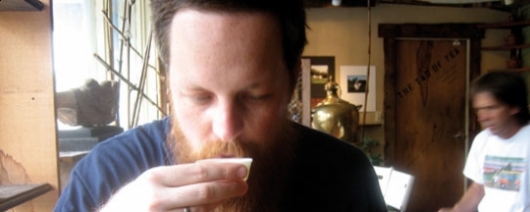Artist Tips: Greg Davis
Like a fine wine, Greg Davis’ work as a minimalist composer has aged well, evolving […]

Like a fine wine, Greg Davis’ work as a minimalist composer has aged well, evolving over the years from folk revivalist hunched over a laptop computer to drone wizard. Whether working as a solo artist or paired with frequent partners Keith Fullerton Whitman, Sebastien Roux, or Steven Hess, Davis’ end results are always blissful, as he manipulates and mutilates an array of beautiful sounds through the use of acoustic instruments, spare electronics, and field recordings. Mutually Arising (Kranky) is the latest in a very long line of superb experiments from the Chicago-based musician, channeling the spirits of John Cage and Pierre Schaeffer through two meaty compositions that expel like a thick, hazy puff of cloud before slowly ascending to breathtaking heights. Here, Davis lets us in on some of the tools that made it all come to life.?
1. 27″ Wuhan Chau Gong
?The resonances of gongs have always fascinated me. I think of pieces by La Monte Young, James Tenney, Rhys Chatham, or Stockhausen that really turned me on to their various sonic possibilities. I bought this particular gong for a tour that Sun Circle (my project with Zach Wallace) did with Joe Grimm (a.k.a. The Wind-Up Bird) back in 2007. We each bought a large gong and had the idea to do an acoustic gong trio at the end of each show. The way that large gongs can fill up a room-—like pouring sound into a large cube—is truly amazing. The three gongs were louder than any PA I’ve ever heard in my life.??
2. Max/MSP Software
?There is simply no other program that is as flexible and customizable. I’ve built up a set of unique and personal patches and plug-ins over the years that I use for all of my live performances. I remember one of the first large-scale tours I did back in 2002, laptops had finally gotten fast enough to handle a bit of live processing/DSP in real time. Keith Fullerton Whitman and I both had patches that we were using for our live sets and we used to bounce ideas off each other and brainstorm throughout the whole tour.??
3. Khen Mouth Organ?
I first heard the sound of the Khen from an Ocora Records LP from Lam Saravane. It is a free-reed instrument with origins in Laos, Thailand, and Cambodia. One of my favorite things about the instrument is that it can be played continually because it makes sound on the out-breath as well as the in-breath (like a harmonica). It’s very easy to sustain long tones and chords with it, which taps into my deep interest in drone music. The bright, shimmering overtones and slight microtonal variations coupled with the physical and spiritual act of the breath make the Khen one of my favorite instruments to play.??
4. Alesis ModFX Pedals?
This is a set of stereo effects pedals that Alesis made quite a few years ago, and are sadly out of production now. I’m a big fan of stereo effects and spatialization. They make a phaser, flanger, tremolo/panning, resonance filter, a multi-effects pedal (with ring mod, bit reduction, distortion, comb filter, and frequency shift), and more. All of them are great, and provide a software plug-in-type of process in a physical pedal form with tweakable knobs.??
5. Chimera Synthesis bC16 Patchable Synth
?This is a very small, circular-shaped, battery-powered digital synthesizer, about the size of a CD and about one inch tall. It’s a really compact modular synth that uses small banana-clip-type patch cords to make various synth patches and connections. It has a couple of VCOs, VCF, VCA, ring mod, ADSR, LFO, and a few other features. It is a great source for a really wide variety of sounds, and an excellent portable instrument for live performances.

